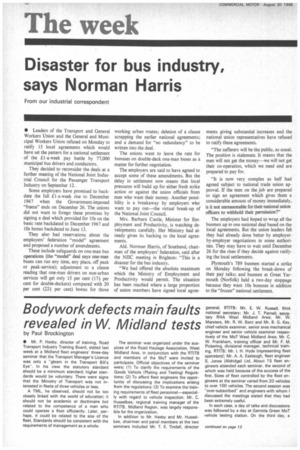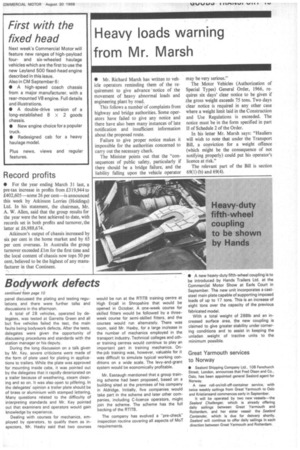Bodywork defects main faults revealed in W. Midland tests
Page 12

Page 15

If you've noticed an error in this article please click here to report it so we can fix it.
by Paul Brockington
• Mr. P. Haxby, director of training, Road Transport Industry Training Board, stated last week at a Midland fleet engineers' three-day seminar that the Transport Manager's Licence was only a "gleam in the Transport Bill's Eye". In his view the statutory standard should be a minimum standard; higher standards would be voluntary. There were signs that the Ministry of Transport was not interested in fleets of three vehicles or less.
A TML, he observed, should not be too closely linked with the world of education; it should not be academic or doctrinaire but related to the competence of a man who could operate a fleet efficiently. Later, perhaps, it could be related to the size of the fleet. Standards should be consistent with the requirements of management as a whole.
The seminar was organized under the auspices of the Road Haulage Association, West Midland Area, in conjunction with the RTITB and members of the MoT were invited to participate. Official objectives of the seminar were; (1) To clarify the requirements of the Goods Vehicle (Plating and Testing) Regulations; (2) To afford fleet engineers the opportunity of discussing the implications arising from the regulations; (3) To examine the training requirements of fleet personnel—especially with regard to vehicle inspection. Mr. C. Husselbee, regional training manager of the RTITB, Midland Region, was largely responsible for the organization.
In addition to Mr. Haxby and Mr. Husselbee, chairmen and panel members at the two seminars included Mr. T. E. Tindall, director general, RTITB; Mr. E. W. Russell, RHA national secretary; Mr. J. T. Parnell, secretary RHA West Midland Area; Mr. W. Marsters, Mr. R. W. Bent and Mr. B. G. Key, chief vehicle examiner. senior area mechanical engineer and senior vehicle examiner respectively of the MoT West Midland Area; Mr. C. W. Frankham, training officer and Mr. F. M. Pickering, divisional manager, technical training, RTITB; Mr. I. H. Hyde (representing fleet operators); Mr. A. A. Eastaugh, fleet engineer S. Jones (Aldridge) Ltd. About 15 fleet engineers attended each seminar, the second of which was held because of the success of the first. Sizes of fleet controlled by the fleet engineers at the seminar varied from 20 vehicles to over 100 vehicles. The second session was "over-subscribed" and engineers with whom I discussed the meetings stated that they had been extremely useful.
In each case, a day of talks and discussions was followed by a day at Garretts Green MoT vehicle testing station. On the third day, a continued on page 13
Bodywork defects
continued from page 10
panel discussed the plating and testing regulations and there were further talks and discussions in the afternoon.
A total of 28 vehicles, operated by delegates, was tested at Garretts Green and all but five vehicles failed the test, the main faults being bodywork defects. After the tests, delegates were given the opportunity of discussing procedures and standards with the station manager or his deputy.
During the long discussion on a talk given by Mr. Key, severe criticisms were made of the form of plate used for plating in applications to trailers. While the plate was approved for mounting inside cabs, it was pointed out by the delegates that it rapidly deteriorated on a trailer because of weathering, steam cleaning and so on. It was also open to pilfering. In the delegates' opinion a trailer plate should be of brass or aluminium with stamped lettering. Many questions related to the difficulty of interpreting standards and Mr. Key pointed out that examiners and operators would gain knowledge by experience.
Dealing with courses for mechanics, employed by operators, to qualify them as inspectors, Mr. Haxby said that two courses would be run at the RTITB training centre at High Ercall in Shropshire that would be opened in October. A one-week course for skilled fitters would be followed by a threeweek course for semi-skilled fitters, and the courses would run alternately. There was room. said Mr. Haxby, for a large increase in the number of mechanics employed in the transport industry. Technical colleges and other training centres would continue to play an important part in training mechanics. Onthe-job training was, however, valuable for it was difficult to simulate typical working conditions on a wide scale. The levy-and-grant system would be economically profitable.
Mr. Eastaugh mentioned that a group training scheme had been proposed, based on a building sited at the premises of his company in Aldridge. Initially, five companies would take part in the scheme and later other companies, including C-licence operators, might join the scheme. The scheme has the full backing of the RTITB.
The company has evolved a "pre-check" inspection routine covering all aspects of MoT requirements.




















































































